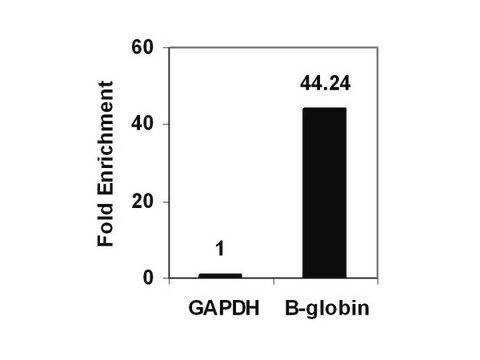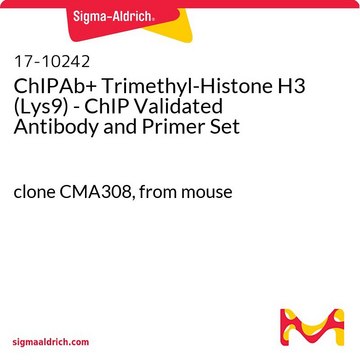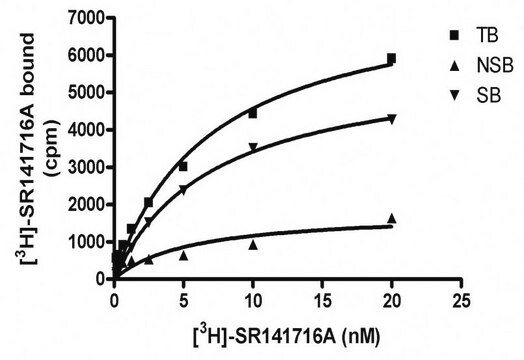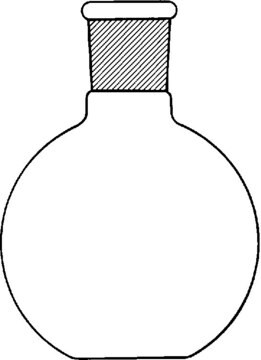17-10108
ChIPAb+ Dimethyl-Histone H3 (Lys27) - ChIP Validated Antibody and Primer Set, rabbit monoclonal
culture supernatant, from rabbit
Synonym(e):
H3K27me2, Histone H3 (di methyl K27), H3 histone family, member M, H3 histone, family 2, histone 2, H3c, histone cluster 2, H3c
About This Item
Empfohlene Produkte
Biologische Quelle
rabbit
Qualitätsniveau
Antikörperform
culture supernatant
Klon
monoclonal
Speziesreaktivität
vertebrates
Hersteller/Markenname
ChIPAb+
Upstate®
Methode(n)
ChIP: suitable
cell based assay: suitable
immunoprecipitation (IP): suitable
western blot: suitable
Isotyp
IgG
NCBI-Hinterlegungsnummer
UniProt-Hinterlegungsnummer
Versandbedingung
dry ice
Verwandte Kategorien
Allgemeine Beschreibung
The ChIPAb+ Dimethyl-Histone H3 (Lys27) set includes the Dimethyl-Histone H3 (Lys27) antibody, a negative control rabbit supernatant, and qPCR primers which amplify a 110 bp region of human β-globin promoter. The Dimethyl-Histone H3 (Lys27) and negative controls are supplied in a scalable "per ChIP" reaction size and can be used to functionally validate the precipitation of Dimethyl-Histone H3 (Lys27)-associated chromatin.
Spezifität
Immunogen
Anwendung
Epigenetik & nukleäre Funktionen
Histone
Representative lot data.
Sonicated chromatin prepared from HeLa cells (1 X 10E6 cell equivalents per IP) were subjected to chromatin immunoprecipitation using either 2 µL of Negative Control Supernatant or 2 µL of Anti-dimethyl-Histone H3 (Lys27) and the Magna ChIP® A Kit (Cat. # 17-610).
Successful immunoprecipitation of dimethyl-Histone H3 (Lys27) associated DNA fragments was verified by qPCR using ChIP Primers, human β-globin as a positive locus, and GAPDH promoter primers as a negative locus (Please see figures). Data is presented as percent input of each IP sample relative to input chromatin for each amplicon and ChIP sample as indicated.
Please refer to the EZ-Magna ChIP A (Cat. # 17-408) or EZ-ChIP (Cat. # 17-371) protocol for experimental details.
Western Blot Analysis:
Representative lot data.
A 1:1000-1:5000 dilution of a previous lot detected dimethyl-Histone H3 in acid extracted proteins from HeLa cells, but did not detect unmethylated recombinant Histone H3 (Catalog # 14-494).
Recombinant Histone H3 (lane 1) and HeLa cell acid precipitate (lane 2) were resolved by electrophoresis, transferred to nitrocellulose and probed with anti-dimethyl-Histone H3 (Lys27) (1:1000 dilution).
Proteins were visualized using a goat anti-rabbit secondary antibody conjugated to HRP and a chemiluminescence detection system.
Arrow indicates dimethyl-histone H3 (~17 kDa) (Please see figures).
Peptide Inhibition Assay (PIA):
Representative lot data.
0.5-2 μM of histone H3 peptides containing dimethyl-Lys27 abolished detection of histone H3 by anti-dimethyl-Histone H3 (Lys27) (1:1000 dilution) in immunoblots of acid extracted proteins from HeLa cells.
Acid extracted proteins from HeLa cells were resolved by electrophoresis, transferred to nitrocellulose and probed with anti-dimethyl-Histone H3 (Lys27) (lane 1) or anti-dimethyl-Histone H3 (Lys27) preabsorbed with 0.5 mM of histone H3 peptides containing the following modifications:
Lane 2: dimethyl-lysine 23
Lane 3: dimethyl-lysine 27
Lane 4: dimethyl-lysine 9
A 1:1000 dilution of the primary antibody was used.
Proteins were visualized using a goat anti-rabbit secondary antibody conjugated to HRP and a chemiluminescence detection system.
Arrow indicates dimethyl-histone H3 (~17 kDa) (Please see figures).
Verpackung
Qualität
Sonicated chromatin prepared from HeLa cells (1 X 10E6 cell equivalents per IP) were subjected to chromatin immunoprecipitation using either 2 µL of Negative Control Supernatant or 2 µL of Anti-dimethyl-Histone H3 (Lys27) and the Magna ChIP® A Kit (Cat. # 17-610).
Successful immunoprecipitation of dimethyl-Histone H3 (Lys27)-associated DNA fragments was verified by qPCR using ChIP Primers, human β-globin (Please see figures).
Please refer to the EZ-Magna ChIP A (Cat. # 17-408) or EZ-ChIP (Cat. # 17-371) protocol for experimental details.
Zielbeschreibung
Physikalische Form
Negative Control Supernatant. One vial containing 100 µL of rabbit cultured supernatant in 0.05% sodium azide. Store at -20°C.
ChIP Primers, human β-globin. One vial containing 75 μL of 5 μM of each primer specific for the human β-globin promoter. Store at -20°C.
FOR: AGG ACA GGT ACG GCT GTC ATC
REV: TTT ATG CCC AGC CCT GGC TC
Lagerung und Haltbarkeit
Handling Recommendations: Upon receipt, and prior to removing the cap, centrifuge the vial and gently mix the solution. Aliquot into microcentrifuge tubes and store at -20°C. Avoid repeated freeze/ thaw cycles, which may damage IgG and affect product performance.
Hinweis zur Analyse
Includes negative control rabbit supernatant and primers specific for human β-globin promoter.
Rechtliche Hinweise
Haftungsausschluss
Lagerklassenschlüssel
10 - Combustible liquids
Analysenzertifikate (COA)
Suchen Sie nach Analysenzertifikate (COA), indem Sie die Lot-/Chargennummer des Produkts eingeben. Lot- und Chargennummern sind auf dem Produktetikett hinter den Wörtern ‘Lot’ oder ‘Batch’ (Lot oder Charge) zu finden.
Besitzen Sie dieses Produkt bereits?
In der Dokumentenbibliothek finden Sie die Dokumentation zu den Produkten, die Sie kürzlich erworben haben.
Unser Team von Wissenschaftlern verfügt über Erfahrung in allen Forschungsbereichen einschließlich Life Science, Materialwissenschaften, chemischer Synthese, Chromatographie, Analytik und vielen mehr..
Setzen Sie sich mit dem technischen Dienst in Verbindung.








